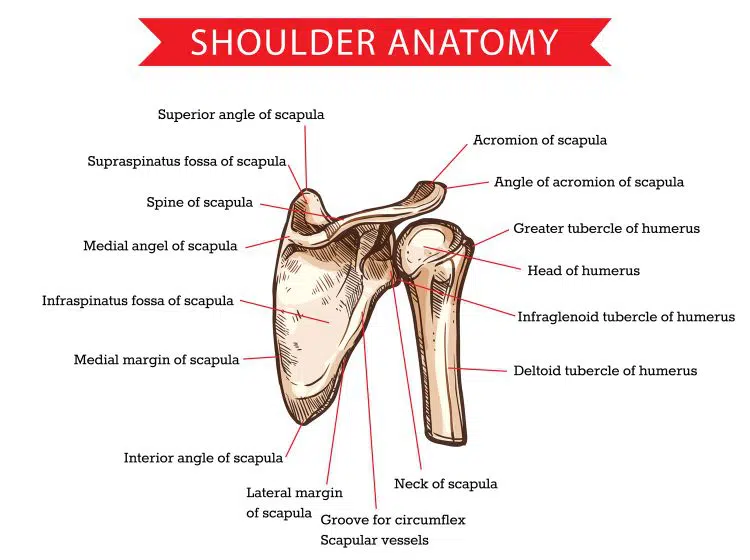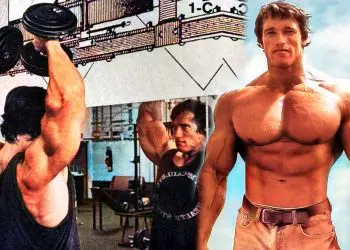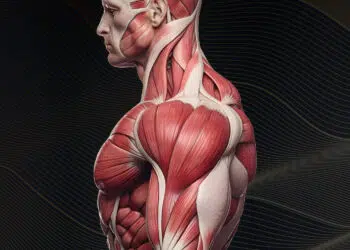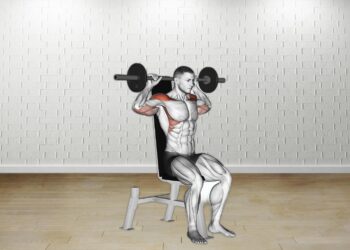Rotator cuff tears are the most common shoulder injury [1] sustained by athletes and bodybuilders.
The group of muscles and tendons surrounding your shoulder joint keep your arm firmly in its socket, but people who lift heavy objects over their head—such as painters, carpenters, or weight trainees—are more at risk of tearing the soft connective tissue.
Strengthening your rotator cuff muscles is crucial for not only building more injury-resistant joints, but also developing greater overhead pushing power for exercises like Military Presses and Arnold Presses.
Of the four rotator cuff muscles, it’s the infraspinatus muscle that often sustains damage. Swimmers and tennis players are susceptible, as are weight trainees.
More often than not, it’s a repetitive strain injury rather than a tear caused by sudden movement (though, as you’ll see below, sudden impact can tear the muscles, too). This means that paying extra attention to your infraspinatus muscle is the key to reducing this particular rotator cuff injury.
Below, we’re going to take a closer look at the anatomy of your infraspinatus muscle, how it’s likely to be injured, and what exercises will help to bulletproof it.
Level Up Your Fitness: Join our 💪 strong community in Fitness Volt Newsletter. Get daily inspiration, expert-backed workouts, nutrition tips, the latest in strength sports, and the support you need to reach your goals. Subscribe for free!
By the end of this page, you’ll know exactly how to train your infraspinatus muscle to drastically decrease your injury risk AND increase your shoulder power.
Infraspinatus Anatomy
The rotator cuff is a group of muscles and tendons that act as a sort of “cage” to keep the upper head of your humerus (upper arm bone) stable in its shoulder socket. The muscles also allow you to lift and rotate your arm.
The four parts of your rotator cuff are:
- Teres Minor – This is the smallest of the rotator cuff muscles. It plays a role in rotating your arm outward, away from your body.
- Subscapularis – This is the largest and strongest of the rotator cuff muscles. It connects your shoulder blade and upper arm bone, allowing you to hold your arm straight out, lower it, and rotate it.
- Supraspinatus – This muscle stabilizes your upper arm and holds the humerus in place, as well as aiding in lifting your arm.
- Infraspinatus – This is the primary muscle that allows you to extend your arm and rotate the joint.
Tears to the rotator cuff muscles are the most common rotator cuff injuries, and they typically result from repetitive use that leads to strain. Repetitive muscle strains cause small or partial tears in the rotator cuff muscles.
However, a direct fall on your arm or an attempt to lift something very heavy can also cause a sudden, large tear in the muscles.
For these large tears, it’s likely to require surgery [2]. Smaller and partial tears, on the other hand, can often be treated through medication and physical therapy.
Physical therapy, in particular, is highly effective, and the focus of this article. We’re going to look at how to use exercise and stretching to strengthen the infraspinatus muscle to both prevent and treat injuries.
Below, we’ve compiled a list of the most effective infraspinatus exercises you can incorporate into your weekly workouts to help bulletproof these important shoulder muscles.
The 6 Best Infraspinatus Exercises
1. Pendulum
This is a simple stretch recommended by the American Academy of Orthopedic Surgeons [3] to target not only your infraspinatus muscles, but also your deltoids, subscapularis, and supraspinatus muscles. This shoulder-focused stretch will extend your range of motion, loosen tight muscles, and help you limber up for a shoulder workout.
To perform the exercise:
- Stand next to something you can lean on: a table, a barre bar, the back of a chair, a barbell rack, etc.
- Lean on the supporting object and bend forward slightly so your left arm hangs freely in front of you.
- Keep your knees bent and your back straight. Resist the urge to round or use your back in any way.
- Using only your shoulder muscles, begin swinging your arm gently forward and backward. Swing for 5-10 seconds.
- Next, swing your arm side to side, again for another 5-10 seconds.
- Finally, swing your arm in a circular motion for another 5-10 seconds.
- Repeat with your right arm.
It’s a simple stretch that will get blood flowing to your shoulder muscles, and the weight of your hanging arm will force the infraspinatus and other rotator cuff muscles to work just enough for the back-and-forth/side-to-side/circular motion.
Level Up Your Fitness: Join our 💪 strong community in Fitness Volt Newsletter. Get daily inspiration, expert-backed workouts, nutrition tips, the latest in strength sports, and the support you need to reach your goals. Subscribe for free!
2. Sleeper Stretch
This is another very useful warm-up exercise recommended by the AAOS, one that will work both your infraspinatus and teres minor muscles. It requires no equipment and can be done multiple times throughout the day as PT for an injured rotator cuff—or simply to strengthen your infraspinatus muscles.
To perform this stretch:
- Lie on your right side, either on the floor or a firm bed. Place a pillow beneath your head to maintain neutral spine and shoulder alignment.
- Place your shoulder and elbow firmly on the bed or floor in front of you. Bend your arm at a 90-degree angle.
- Use your left hand to start pushing the right hand down toward the bed/floor. Be careful not to press on your wrist—instead, all the pressure should be applied to your upper forearm.
- Push your arm down until you feel tension in the back of your shoulder.
- Maintain this stretched position for 30 seconds, then relax for 30 seconds.
- Repeat 3 more times on your right side, then shift onto your left side and repeat.
Watch this video to see how it’s done
3. Passive External Rotation
For one last pre-workout warm-up, try this simple but highly effective rotating stretch. You can do it 4-5 times a day, every day of the week, and it will go a long way toward strengthening your infraspinatus and teres minor muscles.
To perform this exercise:
- You will need a stick at least 3 feet long. Hold the stick firmly in your right hand, and cup your left hand over the other end.
- Bend your arms to a 90-degree angle in front of you. Keep your shoulders relaxed, head up, and back straight.
- With your right hand, push the stick against your left hand to rotate your left arm outward.
- Push until you feel mild to moderate tension. Stop before you feel pain.
- Once you find the right spot, hold the pose for 30 seconds, then relax for 30 seconds.
- Repeat 3 more times, then switch to the left arm.
Shoulder External Rotation Stretch Demonstration
4. Side Lying Wiper
Time to get training those muscles! One 2013 study [4] compared the effects of four different exercises and found that the Side Lying Wiper was the MOST effective for selective activation of the infraspinatus muscles. Essentially, the infraspinatus muscle was activated to the max with minimal deltoid involvement.
This is an easy exercise you can do with fairly light weights. All you need is a firm surface to lie down—such as a carpeted floor or on a Yoga mat—and a dumbbell, and you’re ready to go.
To perform this exercise:
- Lie on your right side, with your knees bent slightly and your hand/arm supporting your head as shown in the video example.
- Grip a light dumbbell in your left hand. Place your elbow firmly against your left side.
- Without removing your elbow from your side and moving only your forearm and shoulder muscles, rotate your arm to bring the weight upward until it is directly above your left side.
- Lower slowly to the ground, rest for a 1-count, and repeat.
- Perform a set of 10-15 repetitions, then switch over to your left side and right arm.
- Perform 3 sets per side, without resting between each set.
Side lying dumbell rotator cuff exercise
5. Prone Horizontal Abduction with External Rotation
In the same 2013 study mentioned above, this exercise was rated second-best after the Side Lying Wiper in terms of selective infraspinatus muscle activation. However, in a 2017 study [5], this exercise led to better concentric peak torque than the Side-Lying Wiper.
The beauty of this exercise is that it requires very little weight but does an amazing job of conditioning your infraspinatus and posterior deltoid muscles.
To perform this exercise:
- You’ll need to lie face-down on an elevated surface, such as your bed or a table.
- Dangle your right arm off the edge of the elevated surface, gripping a dumbbell in your right hand.
- Pull your shoulder blades down and back, and twist your wrist so your thumb points outwards, away from your body.
- Keeping your arms perfectly straight, perform a horizontal lift, raising your thumb toward the ceiling.
- Raise your arm until it is parallel with your body, hold for a half-count, then slowly lower back down to the starting position.
- Repeat for 10-15 repetitions, rest for 30 seconds, and continue until you have completed 4 sets.
- Switch to your left hand and repeat for 4 sets of 10-15 reps each.
Prone Horizontal Abduction with External Rotation
6. Standing External Cable Rotation
Standing External Rotation exercises are amazing for your rotator cuff. However, using a dumbbell will actually focus the exercise on your bicep (as you have to maintain the half-curl position). Instead, work with a cable machine to push your muscles through the rotating exercise to strengthen your infraspinatus muscles.
To perform this exercise:
- Stand sideways and to the left of the cable machine, gripping the cable machine handle with your right hand. Set the handle to the height of your upper abdomen so your arm is at a 90-degree angle.
- Keep your elbow close by your side, your back straight, shoulders relaxed, and head up.
- Without moving your elbow or upper arm, rotate at the shoulder to bring the cable across your body and as far outward as you can manage.
- Control your motion as you return to the original position, and pause for a 1-count before performing the next repetition.
- Repeat for 10-15 reps using very little weight. You should feel a slight burn, but not be straining so hard you are tempted to “cheat” to complete the set.
- Perform 4 sets per arm.
Standing External Rotation
Also read:
- 13 Ways to Avoid Shoulder Pain in The Gym
- 13 Ways to Prevent Elbow Pain When Working Out
- Oblique Pain: Muscle Strain Or Sports Hernia?
- Anterior Deltoid Exercises
- Bodyweight Shoulder Exercises
In Conclusion
Your rotator cuff—and your shoulder joint overall—is susceptible to injury when you perform a lot of very heavy overhead lifts. If you find yourself struggling to lift because of pain or tension in your shoulders, you could run the risk of a repetitive strain injury as a result of either overworking or overloading your shoulder muscle.
That’s why it’s so important that you train your rotator cuff—and, specifically, your infraspinatus muscle. This muscle plays a critical role in the outward rotation of your arm, as well as the fluid motion of lifting things over your head. Whether you need to lift heavy objects in your daily work or as part of your regular resistance training routine, having a stronger infraspinatus muscle will drastically reduce your risk of rotator cuff injuries.
The exercises and stretches above will help you pay extra attention to this vital muscle. You’ll be much more bulletproof against shoulder joint injuries because you spent more time loosening and strengthening your infraspinatus muscle!
References:
1. Minagawa, Hiroshi; Yamamoto, Nobuyuki; Abe, Hidekazu; Fukuda, Masashi; Seki, Nobutoshi; Kikuchi, Kazuma; Kijima, Hiroaki; Itoi, Eiji (2013-02-26). Prevalence of symptomatic and asymptomatic rotator cuff tears in the general population: From mass-screening in one village. Journal of Orthopaedics. 10 (1): 8–12. doi:10.1016/j.jor.2013.01.008.
2. What Is My Rotator Cuff?. WebMD.
3. Rotator Cuff and Shoulder Conditioning Program. OrthoInfo by AAOS: American Academy of Orthopaedic Surgeons.
4. Ha, Sung-Min; Kwon, Oh-Yun; Cynn, Heon-Seock; Lee, Won-Hwee; Kim, Su-Jung; Park, Kyue-Nam (2013). Selective Activation of the Infraspinatus Muscle. Journal of Athletic Training. 48 (3): 346–352. doi:10.4085/1062-6050-48.2.18.
5. Yu, Il-Young; Lee, Dong-Kyu; Kang, Myoung-Joo; Oh, Jae-Seop (2019-03-01). Effects of 3 Infraspinatus Muscle Strengthening Exercises on Isokinetic Peak Torque and Muscle Activity. Journal of Sport Rehabilitation. 28 (3): 229–235. doi:10.1123/jsr.2017-0110.
Interested in measuring your progress? Check out our strength standards for Arnold Press, Military Press.









